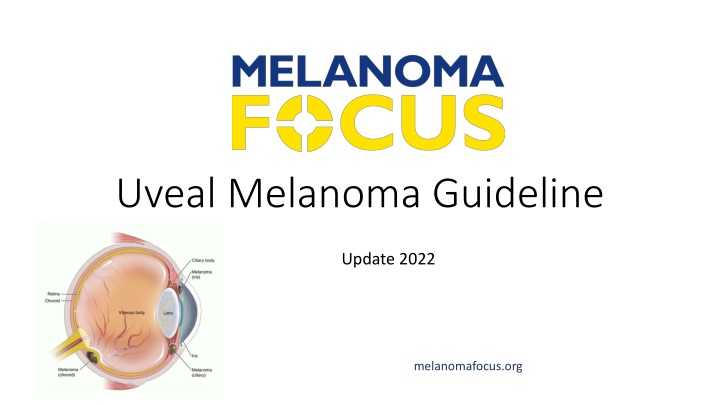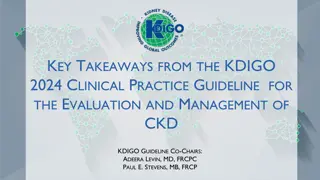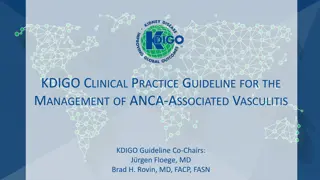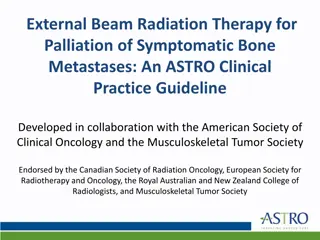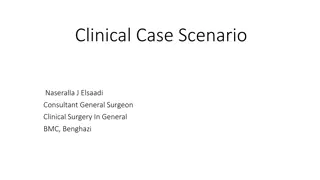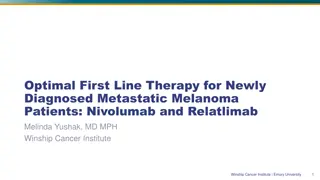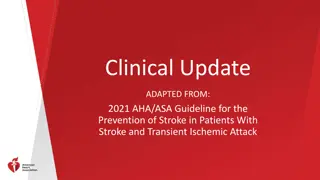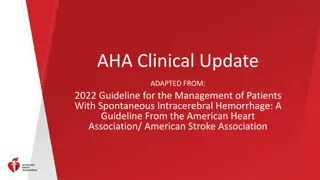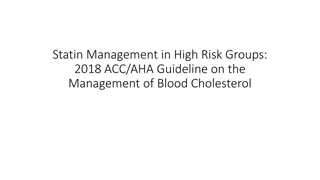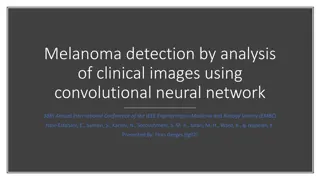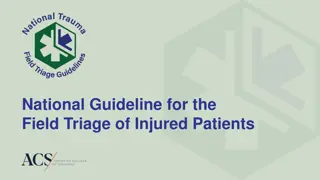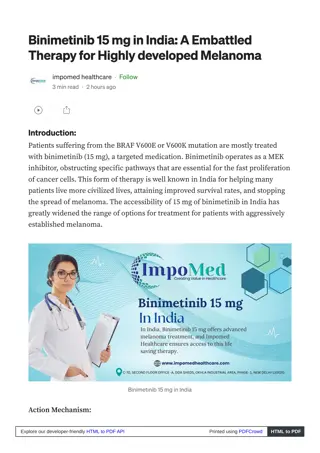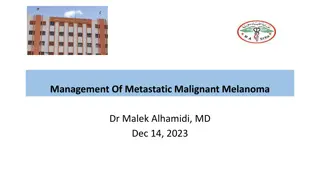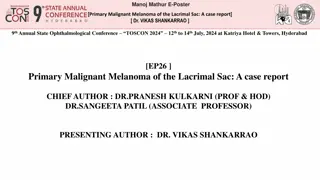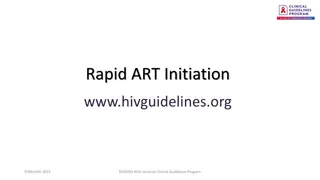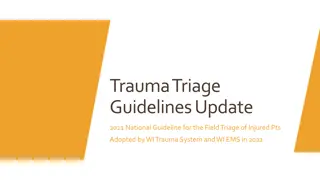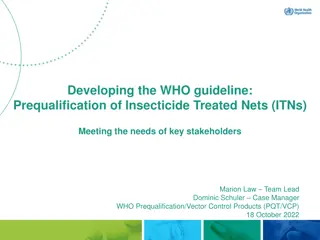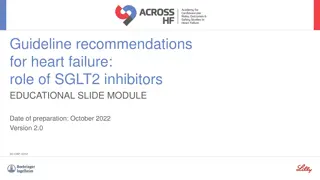Uveal Melanoma Guideline Update 2022: Summary & Recommendations
This update focuses on the guideline development process for uveal melanoma, detailing the methodology employed by the Guideline Development Group led by experts in the field. The group consists of renowned professionals from various medical backgrounds. The new recommendations touch on aspects like patient information and support, genetic and molecular features, adjuvant therapy, systemic therapy, and loco-regional management of the disease. Patients are advised to receive personalized information, record consultations, and be informed about their condition, treatment options, and available resources. The guideline highlights the importance of quality standards in delivering patient-centered care.
Download Presentation

Please find below an Image/Link to download the presentation.
The content on the website is provided AS IS for your information and personal use only. It may not be sold, licensed, or shared on other websites without obtaining consent from the author.If you encounter any issues during the download, it is possible that the publisher has removed the file from their server.
You are allowed to download the files provided on this website for personal or commercial use, subject to the condition that they are used lawfully. All files are the property of their respective owners.
The content on the website is provided AS IS for your information and personal use only. It may not be sold, licensed, or shared on other websites without obtaining consent from the author.
E N D
Presentation Transcript
Uveal Melanoma Guideline Update 2022 melanomafocus.org
Methodology Open recruitment of Guideline Development Group Clinical questions Literature search Evidence review Discussion and agreement of recommendations Drafting Consultation Write-up and publications Funded by Melanoma Focus & OcuMel UK
Guideline Development Group Mt Vernon Cancer Centre, Northwood Dr Paul Nathan (Chairman) Coupland Medical Oncologist George Holt Chair in Pathology, University of Liverpool Prof Sarah Histopathologist Bartholomew's Hospital, Barts Health NHS Trust Dr Dr Rachel Sachin Lewis Modi Clinical Oncologist Interventional Radiologist University Hospital Southampton Bartholomew's Hospital, Barts Health NHS Trust Dr Sukaina Retired Rashid January 2021 Medical Oncologist The Clatterbridge Cancer Centre & University of Liverpool Dr Joe Sacco Medical Oncologist Department of Oncology and Metabolism University of Sheffield Francis Crick Institute Dr Karen Sisley Senior Lecturer Dr Dr Ms Dr Samra Matthew Wheater Audrey Jack Turajlic Medical Oncologist Medical Oncologist Patient Representative Medical Oncology Research Fellow Project Manager University Hospital Southampton Colchester Woraker Broadfoot University Hospital Southampton London Mrs Nancy Turnbull
Whats new? Patient information and support (revised) Genetic and molecular features (new) Adjuvant therapy Systemic adjuvant therapy after surgery (new) Radiation therapy as adjuvant treatment to the orbit (new) Treatment options for macroscopic orbital recurrence (new) Metastatic disease Systemic therapy (revised) Impact of molecular features on choice of therapy (new) Loco-regional management of hepatic predominant disease (revised)
Patient information and support 1. Information should be offered throughout the patient pathway in an individualised manner and provided as needed. Ideally, this should adhere to these quality standards (https://pifonline.org.uk/pif-tick/). 2. Patients should be encouraged to record their consultations, with the knowledge of the clinician and staff. 3. Patients should be given the time and opportunity to discuss their condition and treatment on each visit. This should include: risks and benefits of investigations, procedures and treatments the treatment options available locally and at other centres the pros and cons of prognostication, including the role of tumour biopsy timely information on the roles of other teams in their care signposting to other high-quality resources, for example Melanoma Focus, OcuMel UK, Cancer Research UK, MacMillan and Maggie s.
Patient information and support cont. 4. Each patient should have a named keyworker, with contact details including telephone and e- mail address, who is responsible for communication between the different cancer centre teams caring for the patient and between the cancer centre and primary and secondary care. Ideally, this should be a Clinical Nurse Specialist. 5. Patients should be given scan results as early as possible to mitigate anxiety. 6. Standard care available to all patients nationwide should include: information on the side effects of local or systemic treatment advice for patients and families regarding signs and symptoms that may indicate that the cancer has recurred the offer of psychological support easy access to out-patient review or remote consultation the opportunity to have a family member with them at consultations. This may be done remotely, if necessary the offer of early referral to services, for example, enhanced supportive care, palliative care support services and support groups.
Prognostic factors/tool Prognostic factors/tool 28. and genetic features. The following features should be recorded: Patient age Patient sex Tumour location (i.e. involvement of ciliary body or not) Tumour height Tumour largest basal diameter Ciliary body involvement Extraocular melanoma growth (macroscopic and microscopic). The following features should be recorded if tissue is available: Cell type (modified Callender system) Mitotic count (number/40 high power fields in H&E-stained sections) Presence of extravascular matrix patterns (particularly closed loops ) Presence of extraocular melanoma growth (size in mm; presence/absence of encapsulation; relation to surgical margin) Positive or negative expression of nuclear BAP1 protein in the tumour cells. Prognostic factors of uveal melanoma are multi-factorial and include clinical, morphological
Prognostic factors/tool cont. Prognostic factors/tool cont. 29. The following features should be recorded if cytology of tumour is available: Confirmation of melanoma cells (i.e., exclude differential diagnoses, particularly metastatic carcinoma) immunocytology may be required for this, but is not always necessary. Cell type (modified Callender system), if possible.
Prognostic biopsy 30. There should be a fully informed discussion with all patients, explaining the role of biopsy including the benefits and risks. The discussion should include: Enabling prognostication and allow tailored follow-up Allowing recruitment into adjuvant trials Risks of having the biopsy Limitations of the investigation Effects of prognostication information on quality of life. 31. The minimum dataset for uveal melanoma from the Royal College of Pathology (or national official equivalents) should be recorded in the pathology reports. See: https://www.rcpath.org/profession/publications/cancer-datasets.html 32. Use the most up-to-date edition of the TNM staging system for prognostication and include in pathology/clinical reports.
Prognostic biopsy cont. 33. Collect molecular genetic and/or cytogenetic data for research and prognostication purposes, where tumour material is available and where patient consent has been obtained, as part of an ethically-approved research programme. 34. The use of multifactorial prognostication models incorporating clinical, histological, immunohistochemical and genetic tumour features should be considered. 35. Where available the results of state-of-the-art molecular analysis should be combined with clinical features and standard anatomical and pathological staging for prognostication. 36. Tests for novel circulating blood-borne biomarkers should only be used within clinical trials or research programmes.
Adjuvant therapy Systemic adjuvant therapy after surgery 37. The availability of prognostic tools that allow identification of high-risk primary disease, and the poor outcomes for metastatic uveal melanoma support an adjuvant approach. In the absence of proven therapy, adjuvant systemic therapy should only be given within a well- designed clinical trial. Radiation therapy as adjuvant treatment to the orbit 38. There is very limited evidence for adjuvant radiation therapy to the orbit after definitive surgical treatment of primary disease. It is an option that can be considered for patients deemed to be at high risk of local relapse (e.g., greater than 5mm tumour extra-ocular extension in enucleation samples). Toxicity should be balanced against lack of evidence for efficacy and patients should be counselled on the benefits and risks of radiation therapy. 39. When radiation therapy is indicated, due to the relative radio resistance of melanoma, doses greater than 2Gy per fraction are recommended with a total does of 45-50Gy/20#.
Treatment options for macroscopic orbital recurrence 45. For local macroscopic recurrence in the orbit, there should be a discussion at MDT to discuss surgical and radiotherapy options. 46. When radiation therapy is indicated, due to the relative radio resistance of melanoma, doses greater than 2Gy per fraction are recommended with a total does of 45-50Gy/20#.
Metastatic disease Systemic therapy 54. Pending licencing and availability consider offering tebentafusp to HLA-A*02:01 positive fit patients with metastatic disease. 55. Patients should be considered for clinical trials wherever possible and be informed of available trial options at other centres. 56. Patients with good performance status (PS 0-2) who decline trials or for whom no suitable clinical trials are available should be offered systemic treatments and managed in specialist centres with appropriate oncology expertise in uveal melanoma. 57. Specialist centres should be involved in treatment decisions and review, but a patient may prefer to receive supportive care and systemic treatment locally if possible.
Metastatic disease cont. 58. Systemic immune checkpoint inhibitors (ICI) can be considered in the absence of relevant clinical trials. Without clear evidence of superiority, treatment decisions between single agent and combination ICI require careful discussion regarding the risk of significant toxicity and modest potential additional benefits. 59. For patients with liver only or liver predominant disease, local or locoregional therapy may also be considered. 60. Chemotherapy has limited, if any, efficacy in uveal melanoma, and as such should only be used in the absence of other options and with full discussion of risks and impact on quality of life. 61. Targeted therapy should only be used in the context of a clinical trial.
Impact of molecular features on choice of therapy 62. Screen fit patients for HLA-A*02:01 to identify those who may benefit from tebentafusp 62. Bio-banking and similar efforts in UM should conform to agreed best practices that ultimately could allow for pooling of molecular and clinical data collected in clinical trials and routine care to maximise the likelihood of successfully validating predictive biomarkers.
Loco-regional management of hepatic predominant disease 64. For patients with technically resectable disease, assessment for hepatic resection should be offered where complete macroscopic clearance (RO) can be achieved. 65. Patient selection to ensure complete macroscopic clearance is important to exclude surgery without benefit, including consideration of early interval imaging, in order to exclude rapidly emerging disease. Patent selection should consider these criteria: The extent of liver involved with tumour No more than one site of extra-hepatic disease which is either stable or with an alternative treatment strategy for that site ECOG PS >= 1 Functionally significant underlying liver disease. 66. Laparoscopic assessment should be performed in patients with radiologically resectable liver metastases, as many of these patients will have a miliary pattern of disease. 67. Liver directed and/or systemic treatments should be considered in selected patients with liver dominant disease where resection is not suitable.
Whats not new? Service configuration Primary management Surveillance to be updated separately this year
Supporting information Available on the Melanoma Focus Website https://melanomafocus.org/for- professionals/rare-melanoma-guidelines/uveal-melanoma-guidelines/ Recommendations - Executive summary https://melanomafocus.org/files/pdfs/uveal- melanoma/executive-summary.pdf Care pathway https://melanomafocus.org/files/pdfs/uveal-melanoma/care-pathway.pdf Reviews of evidence and development group summaries - https://melanomafocus.org/files/pdfs/uveal-melanoma/guideline.pdf Methodological detail Appendices 2022 https://melanomafocus.org/files/pdfs/uveal-melanoma/appendix-to-guideline-2022.pdf Appendices 2015 https://melanomafocus.org/files/pdfs/uveal-melanoma/appendix-to-guideline-2015.pdf Patient & Carer Information https://melanomafocus.org/about-melanoma/types-of- melanoma/uveal-melanoma/ Consultation comments and responses - https://melanomafocus.org/files/pdfs/uveal- melanoma/consultation.pdf This slide set - https://melanomafocus.org/files/pdfs/uveal-melanoma/slide-set.pdf
